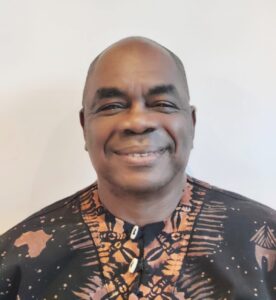The Conservation Society of Sierra Leone (CSSL) has started the nationwide vulture count. During the next weeks, you might see bird watchers in different parts of the country with their binoculars around dumpsites, markets and forest areas to observe and count vultures and other birds.
We asked Dr. Hazell Shokello Thompson, an experienced bird expert, why the vultures are important and what the goals of the vulture count are.
Normal 0 21 false false false DE X-NONE X-NONE /* Style Definitions */ table.MsoNormalTable {mso-style-name:"Table Normal"; mso-tstyle-rowband-size:0; mso-tstyle-colband-size:0; mso-style-noshow:yes; mso-style-priority:99; mso-style-parent:""; mso-padding-alt:0cm 5.4pt 0cm 5.4pt; mso-para-margin-top:0cm; mso-para-margin-right:0cm; mso-para-margin-bottom:8.0pt; mso-para-margin-left:0cm; line-height:107%; mso-pagination:widow-orphan; font-size:11.0pt; font-family:"Calibri",sans-serif; mso-ascii-font-family:Calibri; mso-ascii-theme-font:minor-latin; mso-hansi-font-family:Calibri; mso-hansi-theme-font:minor-latin; mso-bidi-font-family:"Times New Roman"; mso-bidi-theme-font:minor-bidi; mso-font-kerning:1.0pt; mso-ligatures:standardcontextual; mso-fareast-language:EN-US;} Why are vultures and the Hooded Vulture so special for conservation?
The Hooded Vultures in Sierra Leone are not just big brown birds in the sky, they play a really important role in the way our natural environment works and help prevent the spread of diseases. They clear up the remains of dead animals and rotting food very quickly from our environment by eating the carcasses and remains. When they do so, they prevent harmful bacteria and diseases from building up in the dead animals if they were left exposed for a long time. This prevents diseases like rabies from passing from dead dogs and other animals to humans and our livestock like cows, goats and sheep.
Normal 0 21 false false false DE X-NONE X-NONE /* Style Definitions */ table.MsoNormalTable {mso-style-name:"Table Normal"; mso-tstyle-rowband-size:0; mso-tstyle-colband-size:0; mso-style-noshow:yes; mso-style-priority:99; mso-style-parent:""; mso-padding-alt:0cm 5.4pt 0cm 5.4pt; mso-para-margin-top:0cm; mso-para-margin-right:0cm; mso-para-margin-bottom:8.0pt; mso-para-margin-left:0cm; line-height:107%; mso-pagination:widow-orphan; font-size:11.0pt; font-family:"Calibri",sans-serif; mso-ascii-font-family:Calibri; mso-ascii-theme-font:minor-latin; mso-hansi-font-family:Calibri; mso-hansi-theme-font:minor-latin; mso-bidi-font-family:"Times New Roman"; mso-bidi-theme-font:minor-bidi; mso-font-kerning:1.0pt; mso-ligatures:standardcontextual; mso-fareast-language:EN-US;} What is the goal of the vulture count? What will the results be used for?
It has been great to see CSSL start a national count of vultures across Sierra Leone. In many parts of Africa, vulture numbers have dropped drastically, and they have even disappeared in some parts of West Africa. Several vulture species are on the brink of extinction. Here in Sierra Leone, it has been noticed that there seem to be far fewer Hooded Vultures now than there were in previous times but there are no definite records to show whether this is the case.
The goal of the CSSL Vulture count therefore is to obtain information on the numbers of Hooded Vultures across the country including Freetown, Kenema and Kabala. Also the count will identify the locations of major vulture nesting sites and find out the threats the vultures face. Sadly, one main nesting site, the historic Cotton Tree in Freetown, was destroyed by a storm last May, leading to the deaths of many vultures, although CSSL rescued a few.
I hope the results of the counts will be used to make recommendations to the authorities to protect vultures in Sierra Leone, and to raise awareness among the general public on the need to protect our vultures. Once nesting sites have been identified, CSSL will, I am sure, also use its network of members, supporters and collaborators to try to protect these sites.
Normal 0 21 false false false DE X-NONE X-NONE /* Style Definitions */ table.MsoNormalTable {mso-style-name:"Table Normal"; mso-tstyle-rowband-size:0; mso-tstyle-colband-size:0; mso-style-noshow:yes; mso-style-priority:99; mso-style-parent:""; mso-padding-alt:0cm 5.4pt 0cm 5.4pt; mso-para-margin-top:0cm; mso-para-margin-right:0cm; mso-para-margin-bottom:8.0pt; mso-para-margin-left:0cm; line-height:107%; mso-pagination:widow-orphan; font-size:11.0pt; font-family:"Calibri",sans-serif; mso-ascii-font-family:Calibri; mso-ascii-theme-font:minor-latin; mso-hansi-font-family:Calibri; mso-hansi-theme-font:minor-latin; mso-bidi-font-family:"Times New Roman"; mso-bidi-theme-font:minor-bidi; mso-font-kerning:1.0pt; mso-ligatures:standardcontextual; mso-fareast-language:EN-US;} Where do you see the biggest threats to vultures in Sierra Leone?
One of the biggest threats to vultures in Sierra Leone has to be deforestation. Vultures make their nests in tall trees and use the same tree year after year. Because vultures feed off dead animal remains in our villages, towns and cities, they usually nest in trees not far from our main settlements. With the rapid cutting down of trees in many of our cities and our forests, for example in the Western Area Peninsula Forest near Freetown and the Kambui Hills near Kenema, I am sure deforestation is a huge threat to our vultures. In other parts of West Africa, vultures are captured for the use of their parts in traditional medicine and also for food. Casual observations suggest some of this occurs in Sierra Leone as well. The CSSL vulture count will tell us whether actions like these also big threats in Sierra Leone are.
Normal 0 21 false false false DE X-NONE X-NONE /* Style Definitions */ table.MsoNormalTable {mso-style-name:"Table Normal"; mso-tstyle-rowband-size:0; mso-tstyle-colband-size:0; mso-style-noshow:yes; mso-style-priority:99; mso-style-parent:""; mso-padding-alt:0cm 5.4pt 0cm 5.4pt; mso-para-margin-top:0cm; mso-para-margin-right:0cm; mso-para-margin-bottom:8.0pt; mso-para-margin-left:0cm; line-height:107%; mso-pagination:widow-orphan; font-size:11.0pt; font-family:"Calibri",sans-serif; mso-ascii-font-family:Calibri; mso-ascii-theme-font:minor-latin; mso-hansi-font-family:Calibri; mso-hansi-theme-font:minor-latin; mso-bidi-font-family:"Times New Roman"; mso-bidi-theme-font:minor-bidi; mso-font-kerning:1.0pt; mso-ligatures:standardcontextual; mso-fareast-language:EN-US;} What is your hope for the future of vultures in Sierra Leone?
Vultures are part of our national heritage as Sierra Leoneans. My hope is that we will not destroy these majestic birds that have been here before us, and which perform important services for us. I wish that they will again become as abundant in our skies as they were twenty to thirty years ago when we used their presence in the sky over certain places to indicate the locations of traditional ceremonies (e.g. “Awujoh”) where large amounts of food were being prepared.
Hazell Shokellu Thompson, PhD is a Sierra Leonean Conservation Biologist (semi-retired) with more than 30 years’ experience in bird conservation work and ornithology. He was formerly lecturer in Zoology at the University of Sierra Leone; Regional Director of BirdLife International’s Africa Programme based in Nairobi, Kenya; and Global Director, Partnership, Capacity and Communities, BirdLife International, based in Cambridge, UK, where he also served a one-year stint as Interim CEO. He conducted the first comprehensive study of the rare White-necked Picathartes (Picathartes gymnocephalus) in West Africa, a species he has spent a lifetime trying to conserve. He is a life-long supporter of the Conservation Society of Sierra Leone.

Learn more about the value of vultures through our photos and poster:
To open or download the poster, click on the image on the right or this link: Poster – Value of Vultures




